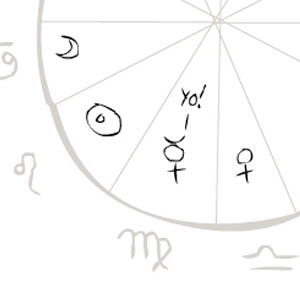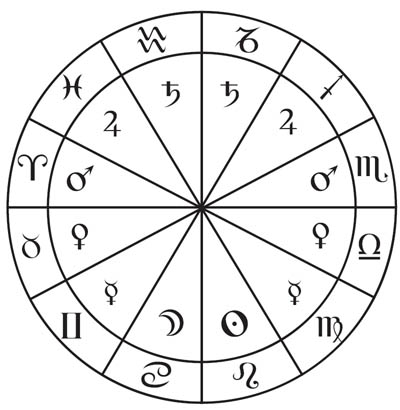 Several years ago I made this animation which depicts the story of how the five classical planets came to rule two signs of the zodiac each.
Several years ago I made this animation which depicts the story of how the five classical planets came to rule two signs of the zodiac each.
It is loosely based on a Medieval Persian story that centers around the Thema Mundi, which is the mythical horoscope for the birth of the world.
The Thema Mundi was invented during the early Hellenistic tradition as a teaching tool in order to explicate certain techniques and concepts.
I learned about the Persian story through a translation of a Greek version of it that was done by Demetra George, although my animation is only a crude attempt to convey the gist of that story in a humorous fashion.
Here it is:
How the Five Classical Planets Came to Rule Their Signs
I added in some text annotations once I uploaded the animation to YouTube since it is kind of hard to read what the planets are saying on a tiny screen without them. You can turn them off if you want to by clicking the little button on the bottom right hand corner of the video and then selecting ‘turn off annotations’.
You can also view a larger version of the video if you click on it and go to its page on YouTube itself, or you can just click here.
The Thema Mundi
The animation starts off with the five visible planets and two luminaries in the positions that they held in the Thema Mundi. Basically, the Sun and the Moon are in Cancer and Leo since those are the two signs that are just after the summer solstice, which corresponds to the warmest and brightest part of the year in the northern hemisphere.
The rest of the planets are placed in the following signs in zodiacal order based on their relative speed and distance from the Sun. Mercury never gets more than 1 sign away from the Sun before he goes retrograde, so he is assigned to Virgo. Venus never gets more than two signs away, so she is assigned to Libra. Mars is the next furthest and slowest planet out. And so on.
This is the basic notion underlying the Thema Mundi, and indeed to some extent underlying the concept of sign rulership in traditional astrology in general.
The Story Underlying the Animation
What happens in the Persian story though is that after the birth of the world the Sun starts moving forward through the zodiac from its starting point in Leo. When it moves into Virgo Mercury is forced to pack up his bags and move over into the furthest unoccupied sign from the Sun in zodiacal order, which is Gemini, since the Sun’s heat is scorching him. Eventually the Sun moves into Libra, and then Venus too must pack up her bags and move as far away as she can get, so she ends up in Taurus.
It goes on like this with all of the planets until eventually the Sun reaches Saturn in Capricorn. Saturn packs up and moves, but he can only get one sign away to Aquarius, so he still ends up getting burnt up by the rays of the Sun. He literally falls under the Sun’s rays or becomes combust.
That is the gist of the Persian story at least. I think that my version is much more hilarious though.
What do you think? Let me know in the comments section below.
Dual Sign Rulership in Traditional Astrology
As I said earlier, this story is based on a Greek translation of a Medieval Persian story. What the story does, in effect, is retroactively explain the dual rulerships of the signs by the five classical planets.
It fleshes out an additional piece of symmetry in the original system, basically showing how there came to be a solar and lunar side of the zodiac, with one planet assigned to each. This creates a symmetrical scheme where each planet has a masculine and feminine sign, a lunar and solar sign, and so on.

This notion of symmetry is very important in traditional astrology, and it is one of the main drawing points for using the traditional rulerships.
Shameless Self-Promotion
If you liked this article then you may be interested in signing up for my Introduction to Hellenistic Astrology Course, where I discuss some of the further implications and applications of the Thema Mundi and related concepts.
4 replies on “How the Classical Planets Came to Rule Two Signs”
This is hilarious, “What’s a glyph like you doing in a domicile like this?”
Chris, this is just so much fun, and what a great teaching tool. Love it! Great job!
Damn,, NR stole my line.
Still the most hilarious moment ^.^
[…] Persian astrologers later developed a myth of their own involving the Thema Mundi in order to explain the rationale behind the rest of the traditional sign rulerships. I created a revised, more modern version of this myth in the form of an animation a couple of years ago when I was learning flash. I took a bit of artistic license with the story, but the gist of it is still the same. You can watch the animation over on my article ‘How the Classical Planets Came to Rule Two Signs‘. […]